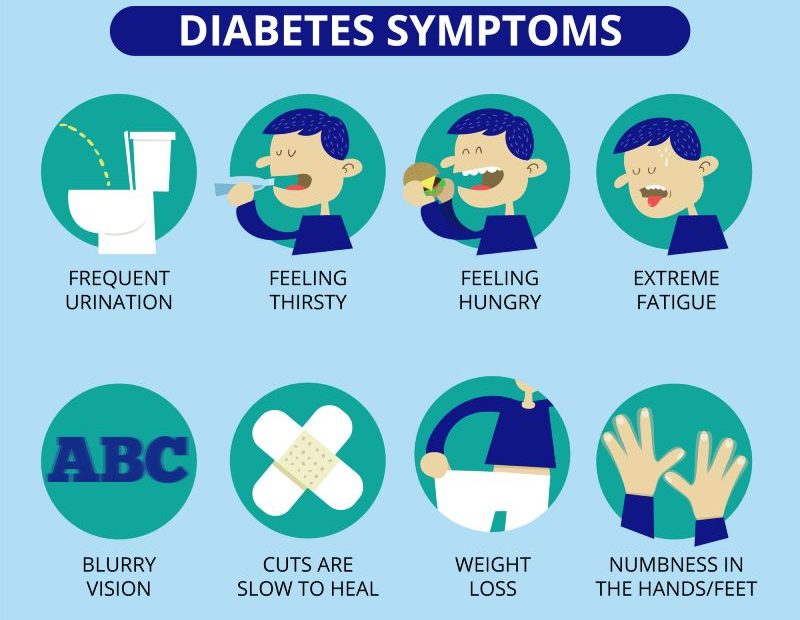Understanding the Symptoms of Type 2 Diabetes
Type 2 diabetes is a chronic condition that affects the way the body processes glucose, which is the body’s primary source of energy. It occurs when the body either doesn’t produce enough insulin or becomes resistant to its effects. Recognizing the early signs and symptoms of this condition is essential for timely diagnosis and management, as uncontrolled type 2 diabetes can lead to serious complications. In this article, we’ll discuss the most common symptoms and share insights from individuals who have experienced them.
1. Increased Thirst and Frequent Urination
One of the most common symptoms of type 2 diabetes is excessive thirst (polydipsia) and frequent urination (polyuria). As blood sugar levels rise, the kidneys work harder to filter the excess glucose, leading to increased urination. This, in turn, causes dehydration and increased thirst.
“I was constantly thirsty, no matter how much water I drank. It felt like my body couldn’t get enough, and I was constantly running to the bathroom.”
2. Fatigue and Weakness
Another common symptom of type 2 diabetes is fatigue and weakness. When the body’s cells don’t receive enough glucose, they can’t produce the energy needed for daily activities. As a result, individuals with high blood sugar often feel tired and lack energy.
“I was always tired, even after a full night’s sleep. It felt like I was dragging myself through the day, and I just couldn’t keep up with my normal routine.”
3. Blurred Vision
High blood sugar levels can cause the lens in the eye to swell, leading to blurred vision. This change in vision can occur rapidly and may fluctuate with varying blood sugar levels. While blurred vision may be a temporary symptom, it is important to address it promptly to prevent long-term damage to the eyes.
“My vision started to get blurry out of nowhere. I thought I needed new glasses, but it turned out my blood sugar was the culprit.”
4. Slow Healing of Wounds and Frequent Infections
Individuals with type 2 diabetes may experience slow healing of wounds and frequent infections. High blood sugar levels can impair the immune system’s ability to fight off infections and can slow down the healing process, increasing the risk of complications from cuts, scrapes, and other injuries.
“I noticed that even small cuts would take weeks to heal, and I seemed to catch every cold and flu going around.”
5. Numbness or Tingling in the Hands or Feet
Over time, high blood sugar levels can damage the nerves, particularly in the extremities. This nerve damage, known as diabetic neuropathy, can cause numbness, tingling, or pain in the hands or feet.
“I started experiencing tingling and numbness in my feet. It was an odd sensation, like pins and needles.”
Recognizing the Signs and Seeking Medical Help
While these symptoms are common in individuals with type 2 diabetes, it is important to note that some people may experience no symptoms or only mild ones. If you notice any of these symptoms or a combination of them, it is crucial to consult with a healthcare professional for proper evaluation and diagnosis. Early detection and management of type 2 diabetes can significantly reduce the risk of complications and improve overall quality of life.
Importance of Regular Checkups and Monitoring
Since some individuals with type 2 diabetes may not experience any symptoms, regular checkups and blood sugar monitoring are essential for early detection and management of the condition. It is especially important for those with risk factors, such as a family history of diabetes, obesity, or a sedentary lifestyle, to be proactive in their healthcare and regularly consult with their healthcare provider.
“I didn’t have any obvious symptoms, but my doctor caught my elevated blood sugar levels during a routine checkup. Thanks to that early detection, I was able to make lifestyle changes and manage my diabetes more effectively.”
Summary
Type 2 diabetes is a serious, chronic condition that can lead to a variety of health complications if left unmanaged. By recognizing the common symptoms of type 2 diabetes, such as increased thirst and urination, fatigue, blurred vision, slow healing of wounds, and numbness or tingling in the extremities, individuals can seek medical help early and work with their healthcare providers to develop an effective management plan. Regular checkups and blood sugar monitoring are crucial in the early detection and management of the condition, particularly for those with risk factors. Remember, knowledge and awareness are key to successfully managing type 2 diabetes and leading a healthy, active life.
